How to Organize Golf Bag: Clubs and Pockets
By: Scott Brera | Last Updated: April 22, 2024
To excel at golf, efficiency is key, and it starts with knowing how to organize golf bag. This article tackles that exact challenge: “How to Organize A Golf Bag.” It’ll break down the essentials of club arrangement to storage tips for quick gear retrieval, so that every move you make on the course is swift and decisive.
Key Takeaways
- Organize your golf clubs in a logical descending order from longest to shortest in your bag to save time and protect the clubs.
- Utilize specialized compartments effectively, like the apparel pocket for clothes and the valuables pocket for personal items, to reduce clutter and ensure easy access to gear.
- Accessorize strategically by giving priority to items like golf balls, tees, and rangefinders, and adopt quick transitions to maintain focus and improve your game.
Mastering Golf Bag Layout
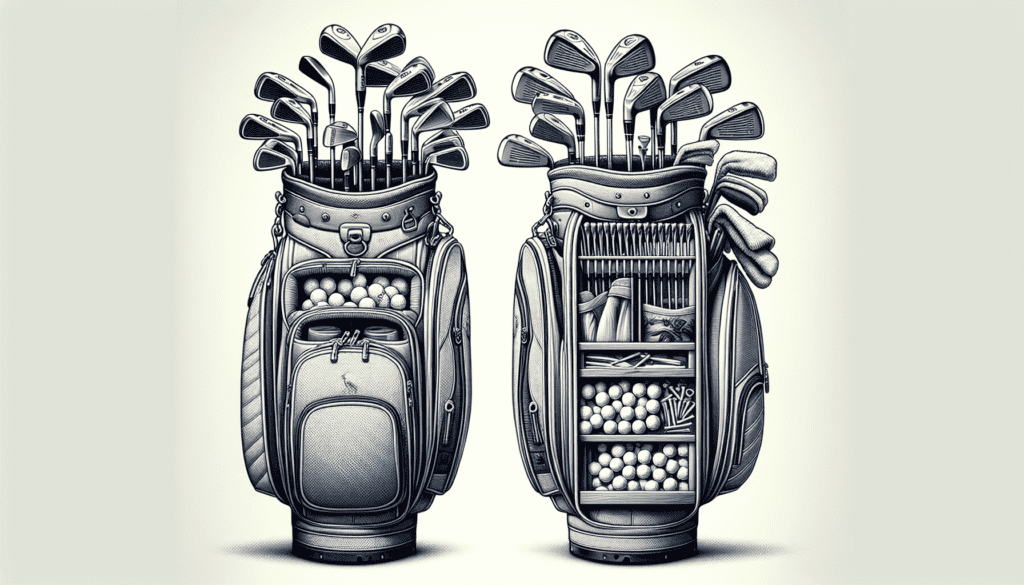
Have you ever watched a professional golfer effortlessly pull the right club at the right moment? That’s no accident; it’s the result of a well-organized golf bag. A strategically arranged bag is your silent caddy, ensuring you stay focused on your swing rather than fumbling for clubs.
The layout of your golf bag should be as strategic as your game plan. Most golf bags are designed with specific sections for each type of club and accessory, ensuring everything has its place. When organized effectively, your bag not only protects your golf gear but also speeds up your game by making club selection intuitive. Here’s how to arrange your clubs and find the perfect spots for your putter and wedges.
The Logical Order of Clubs
The symphony of clinking clubs as you make your way to the tee box should be music to your ears. To arrange golf clubs in a logical order is the first step toward a harmonious round. Start from the top of your golf bag with the longer clubs (driver and woods) and work your way down to the shortest (wedges), ensuring each has its rightful place. It’s like building a crescendo in a musical piece; each club adding its unique note as you arrange them from drivers to irons.
Imagine the ease of pulling out the right club at a glance, with your woods and driver poised near the shoulder strap and your irons following in an orderly fashion. Arranging your clubs in descending order of loft in a cart bag sets the stage for successful shots. As you move from one hole to the next, this systematic approach not only saves time but also protects the club heads from unnecessary wear and tear.
14-Way Golf Bag Setup
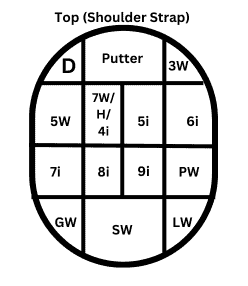
6-Way Golf Bag Setup
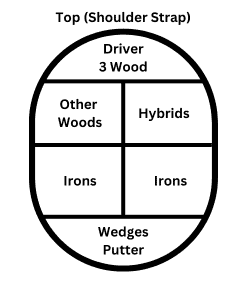
The Special Place for Putter and Wedges
Now let’s talk about the unsung heroes of your golf bag—the putter and wedges. These precision instruments demand their own spot.
Wedges are the shortest clubs and will be at the bottom of the golf bag. Generally, there is a special spot for the putter in all golf bags – the putter well. In a 14-way divider, the putter well will be larger than all of the other slots and may be at the top (shoulder strap side) or bottom of the bag.
Think of your putter and wedges as the closing act in your golf bag’s performance. Insert them back into their special place after the rest of the choir is assembled, and you’ll maintain the neatness of your bag and reduce the time spent rummaging for the right club. This foresight pays off when you’re on the fairway, ready to transition to your short game.
Essential Golf Bag Compartments
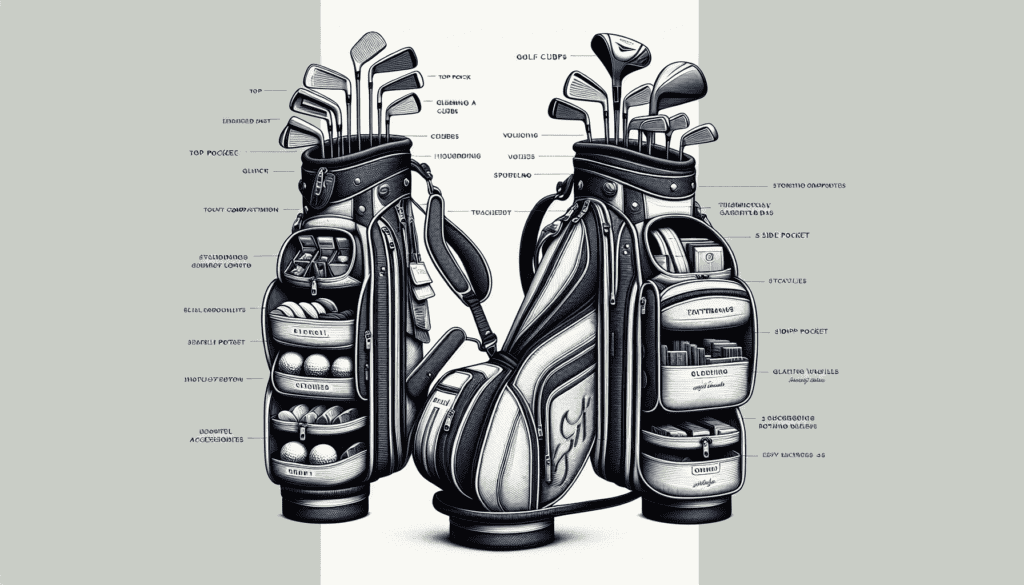
If the clubs are the stars of the show, then the compartments of your golf bag are the supporting cast. Each pocket has a role to play, from the full-length apparel pocket, which is your on-course wardrobe, to the lower front pouch, perfectly sized for your golf balls. However, it isn’t merely about having these pockets, but utilizing them smartly.
The amount of compartments and pockets will vary depending on the type of golf bag you have. Carry bags and stand bags, which are lighter weight bags meant to be carried while walking the course, have considerably less pockets than their counterpart cart bags, which are heavier with more pockets and are meant to strap onto a cart.
Regardless of the type of bag you have, a well-organized golf bag offers easy access to your gear while protecting it from the elements and accidental damage. That means keeping a light jacket, vest, or rain gear in the apparel pocket, where it’s readily available but not crumpled or crammed. And when it comes to your treasure trove of golf balls, that lower front pouch isn’t just convenient; it’s a strategic choice that keeps them at your fingertips, ready for action.
The Apparel Pocket: More Than Just Clothes
The apparel pocket is the large, long side pocket on either one side or both sides of your golf bag. Long side pockets are not just a fashion statement; they’re there to keep your spare clothing and rain gear dry, wrinkle-free, and within reach. Imagine the convenience of slipping into a dry jacket after a sudden downpour, all thanks to the foresight of packing in the right compartment.
But it’s not just about dry clothes; it’s about smart packing. The apparel pocket should be dedicated to clothing alone, keeping it separate from the smaller items like tees and divot tools that could snag or rip your apparel. Reserving this space solely for clothes guarantees comfort and a sharp look throughout your round.
The Valuables Pocket: Your Personal Safe
On the course, the valuables pocket is your personal safe, a secure spot for the items you can’t afford to lose. This pocket is often lined with fleece or a similar material to protect your phone, wallet, and other personal items from scratches or damage.
The valuables pocket is more than just a compartment; it’s peace of mind. Knowing that your essentials are stored away securely means you can focus on your game without worrying about where you left your wallet or whether your phone was left on top of the golf cart. While your mind is on the fairway, your valuables are tucked away safely, just where you left them.
Typically, golf bags only have one valuables pocket. When storing your phone in this pocket, take care not to also store your car keys in the same pocket as it may scratch your phone screen.
Accessorize Like a Pro

Accessories might be small, but they can have a big impact on your game. A pro golfer’s bag is a treasure trove of well-organized golf accessories, from the ever-important golf balls and tees to the humble ball marker. These essentials might not get the limelight like the clubs do, but they’re the unsung heroes that can make or break a hole.
Part of accessorizing like a pro is knowing where each item belongs and ensuring it’s there when you need it. The goal is to establish a system that streamlines your game from the first tee to the last green. With a few simple tips, you’ll be able to reach for your accessories without a second thought, letting you focus on your swing and the game at hand.
Prioritizing Quick Access Items
Quick access items are the ones you reach for time and time again during a round. Golf balls, tees, and ball markers should have their own designated space, ideally separated to prevent a fishing expedition every time you need to tee up. The bottom front pocket is prime real estate for your golf balls; a small, dedicated pocket for tees can prevent them from poking you or damaging other items.
Easy access to essentials accelerates your play and minimizes distractions, allowing you to concentrate on your next shot instead of hunting for your tees.
Securing Your Golf Gear
Securing your golf gear goes beyond just keeping it organized; it’s about protecting your investment and ensuring your accessories are always game-ready. Many golf bags feature a special pocket with extra padding or a hard shell to protect sensitive items like rangefinders. This attention to detail extends to gloves as well, which should be stowed in a waterproof pocket (if available) to keep them dry and ready for use.
The bag’s exterior is equally important. Frequently used items like rangefinders can be attached to the outside of the golf bag, making them easily accessible and reducing the risk of damaging other gear. However, if your bag has a designated spot for a rangefinder, I’d suggest keeping it in there. Just as you wouldn’t put your phone directly in sunlight for 5 hours straight (will likely overheat), I wouldn’t put my rangefinder directly under sunlight for 5 hours while playing.
And don’t forget about those club headcovers; they might seem like a minor accessory, but they’re crucial for protecting your woods and their delicate graphite shafts.
Hydration and Nutrition on the Course
Stepping onto the golf course is like embarking on a marathon, and just like any endurance sport, hydration and nutrition are key to maintaining peak performance. The right drink can be a lifesaver on a hot day, and a light snack can keep your energy up from the first swing to the last putt. However, it’s not merely about carrying a water bottle, but ensuring immediate access.
Most golf bags are equipped with either one or two insulated cooler pockets. The insulated cooler pocket isn’t just a convenience; it’s an essential tool for keeping your drinks cold and your snacks fresh. Whether you choose water, sports drinks, or electrolyte tablets, make sure they’re within easy reach to avoid dehydration and fatigue. And when it comes to snacks, opt for light and energizing options like fruit, nuts, or granola, stored at the top of your bag for easy access.
Do your best to put snacks in a designated pocket (ideally a cooler pocket). I think we’ve all brought that chocolate bar onto the golf course only to see it melt in our hot bag.
Selecting the Best Golf Bag for Your Needs
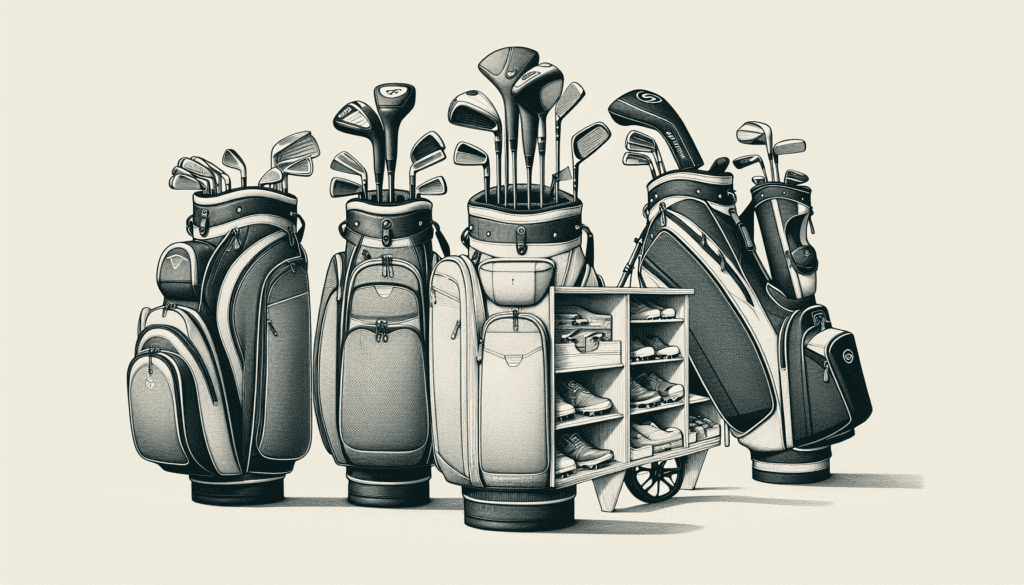
Selecting the best golf bag for your needs is as personal as choosing your clubs. Your bag should reflect your style of play, whether you prefer walking the course with a stand bag or cruising in a cart with a cart bag. The goal is to strike a balance between storage needs and weight, confirming there’s room for all essentials without the burden of an excessively heavy bag.
When considering a new bag, think about the features that matter to you. Are you looking for:
- a lightweight carry bag to ease shoulder fatigue
- a golf bag with 14-way club dividers for superior organization
- waterproof materials to keep your gear dry
Whatever your needs, there’s a golf bag out there that’s the perfect fit for your game.
Packing Smart: Tips for Efficient Bag Organization
Efficient bag organization is the secret weapon of savvy golfers. Efficient packing isn’t just about what you pack, but also how you do it. Smart packing ensures that each item in your golf bag has a purpose and a place, reducing clutter and saving time on the course. With a few simple tips, you can transform your golf bag into a model of efficiency.
For example, tees and divot tools deserve their own small pocket to avoid damaging other items and to keep them easily accessible. Rangefinders and GPS devices should be stored in a pocket where they won’t interfere with other gear (or should be attached to the outside of the bag). While these tips may seem obvious, you’d be surprised how long some people take to find a tee or golf ball in their bag. These simple adjustments will make a big difference in your game, allowing you to focus on your shot rather than on finding your equipment.
Streamlining for Speed: Organizing for Quick Transitions
Streamlining your golf bag isn’t just about organization; it’s about speed. The quicker you can transition from one club to the next, the more focused and effective your game will be. A well-organized bag allows you to maintain a steady pace on the course, keeping your mind on your strategy and your eyes on the ball.
Selecting the appropriate golf bag and adopting straightforward golf club organization tips can significantly cut down the time spent rummaging for gear. This efficiency translates into a smoother, more enjoyable game, letting you move confidently from shot to shot with ease. To achieve this, it’s essential to organize your golf bag properly.
Summary
As we’ve journeyed through the art of organizing a golf bag, it’s clear that the devil is in the details. A well-organized golf bag is more than just a convenience; it’s a vital part of your game that can lead to improved performance and a more enjoyable experience on the course. From the logical arrangement of clubs to the strategic use of pockets, every detail plays a part in crafting a successful round.
Take these tips to heart, and the next time you step onto the course, do so with the confidence that comes from knowing everything is in its rightful place. With a well-organized golf bag, you’re not just prepared for the game—you’re setting yourself up to succeed.
Frequently Asked Questions
How to organize a 14-way golf bag?
Organize a 14 way golf bag by starting at the top of the bag (shoulder strap) and placing your longest club first (driver) and work your way down to the shortest club (lob wedge) so that each club is in its own slot.
How to organize a 6-way golf bag?
Organize a 6 way golf bag by starting at the top of the bag (shoulder strap) and placing your driver and 3 wood in the top slot. Then place your woods and hybrids in the next two slots down, followed by irons, and then wedges and your putter in the bottom divider.
How many golf balls should I carry in my bag?
It depends on the player and the course. If there are a lot of water hazards or you typically lose golf balls quite often, I’d suggest 12 or more to ensure you can finish the round. Otherwise, a minimum of 6 should be sufficient for more advanced players.
Do I really need to use head covers for my woods?
Yes, using head covers on woods is essential to protect the sensitive material of the club-head and graphite shafts from damage. It’s important for maintaining the quality of your clubs and preserving their performance.
How should I store my rangefinder or GPS device for quick access?
To have quick access to your rangefinder or GPS device, store it in a protected pocket with easy access or attach it to the outside of your golf bag.

Scott Brera is the founder of Brera Golf. When he’s not reviewing or testing golf products, he’s typically out chasing that little white ball.
